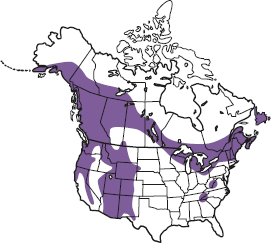Loxia curvirostra

male
The Red Crossbill has a bill with cross-tipped mandibles that are used to extract seeds from conifer cones; this distinctive feature is shared only with the White-winged Crossbill. The sexes are dissimilar. Adult males have red plumage that is darkest and brownest on the wings and tail. Confusingly, the occasional individual has subtle pale wingbars, leading to potential for confusion with the White-winged. Adult females have yellow-green plumage that is darkest and brownest on the wings and tail. Juveniles are streaked brown, and darker above than below. By the first year, immature males are similar to an adult female but the plumage is tinged orange-yellow; first-year females are similar to an adult female.
The Red Crossbill is present year-round in northern and western conifer forests.

female
FACT FILE
LENGTH 6.25 in (16 cm)
FOOD Conifer seeds
HABITAT Conifer forests
STATUS Locally common resident
VOICE Song often includes shrill kip notes, and usually ends in a buzzing trill. Call is a sharp kip-kip, often given in flight
![]()
